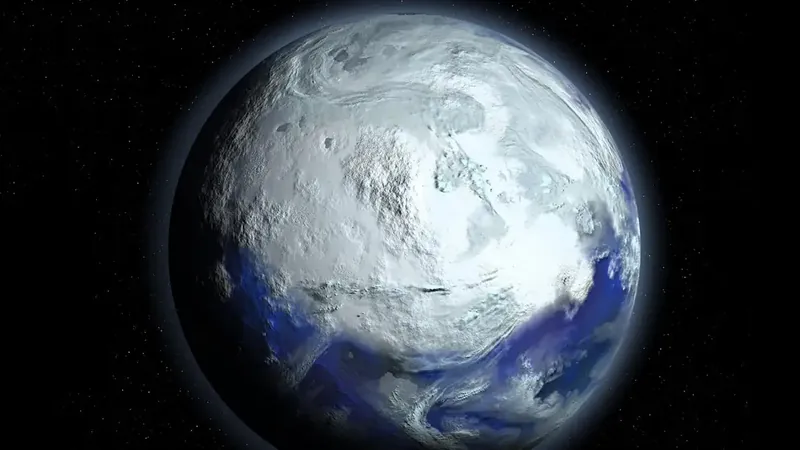
Scientists Crack the Code Behind the Last Ice Age's Ice Sheets!
2025-04-14
Author: Amelia
Unlocking an Ancient Climate Mystery
For years, climate experts were left scratching their heads over two significant questions: What triggered the formation of massive ice sheets during the last ice age, and how did they expand so swiftly? New research from the University of Arizona might just hold the key!
The Ice Sheet Surge Explained
Published in *Nature Geoscience*, this groundbreaking study dives deep into why colossal ice sheets once engulfed the Northern Hemisphere, spanning regions like Canada, Siberia, and Northern Europe. The team’s insights illuminate the Earth’s natural cycles of freezing and thawing.
Approximately 100,000 years ago, our planet entered a harsh cooling era—the time of the mammoths! Over the subsequent 10,000 years, tiny mountain glaciers expanded, merging into vast ice sheets that buried large swaths of northern continents. While scientists have traditionally linked this expansion to changes in Earth's orbit leading to cooler summers, many unanswered questions lingered.
The Enigma of Mild Regions
One perplexing question remained: Why did ice form in relatively mild areas like Scandinavia? With warm summers fueled by the North Atlantic Current, it seemed illogical for these regions to be engulfed in ice.
Marcus Lofverstrom, the study's lead author and a geosciences professor at the University of Arizona, expressed his surprise: "The Canadian Arctic is expected to see ice formation, but Scandinavia should generally be ice-free!"
Climate Variations Explored
Though they share similar latitudes, the climates of Scandinavia and the Canadian Arctic are starkly different. Lofverstrom’s team utilized an advanced climate model to mirror conditions from the last ice age. By expanding their model to cover more of the Northern Hemisphere, they uncovered fascinating new insights.
The simulations pointed to ocean gateways within the Canadian Arctic Archipelago as critical players. These narrow channels reacted dynamically to climate changes—when they remained open, ice sheets only flourished in the coldest regions. But once these channels were blocked, potentially by marine ice, the North Atlantic circulation faltered, leading to colder temperatures in Scandinavia and encouraging glacial growth.
Evidence from the Depths
To bolster their theory, researchers analyzed marine sediment records from the North Atlantic, which revealed that glaciers in Canada formed thousands of years before those in Europe. These sediment layers supported the hypothesis of weakened ocean circulation during that time, closely aligning with the model’s predictions.
Implications for Today's Climate Challenges
Understanding the mechanics behind glaciation is crucial, not only for deciphering Earth's history but also for predicting shifts in future climates. Lofverstrom cautioned that minor changes today could lead to significant and rapid alterations in ice sheets, directly impacting sea levels and global weather patterns.
This principle could also shed light on past cold spells, like the Younger Dryas, which interrupted the warming trend at the end of the last ice age.
A Collaborative Scientific Triumph
This study highlights the power of collaboration across disciplines, featuring experts in geosciences, oceanography, and climate modeling. Such teamwork, combined with advanced computational tools, enables researchers to unravel the complex interactions within our planet’s climate system.
As research continues, Lofverstrom remains committed to exploring the intricate climate dynamics that have shaped our world. He believes this study is just the beginning, paving the way for further exploration into these vital topics.
Lessons for the Future
In an age where the specter of climate change looms ever larger, the findings serve as a potent reminder that even slight shifts in Earth's climate system can yield monumental consequences. As we navigate our future, understanding these atmospheric, oceanic, and glacial interactions is more crucial than ever!









 Brasil (PT)
Brasil (PT)
 Canada (EN)
Canada (EN)
 Chile (ES)
Chile (ES)
 Česko (CS)
Česko (CS)
 대한민국 (KO)
대한민국 (KO)
 España (ES)
España (ES)
 France (FR)
France (FR)
 Hong Kong (EN)
Hong Kong (EN)
 Italia (IT)
Italia (IT)
 日本 (JA)
日本 (JA)
 Magyarország (HU)
Magyarország (HU)
 Norge (NO)
Norge (NO)
 Polska (PL)
Polska (PL)
 Schweiz (DE)
Schweiz (DE)
 Singapore (EN)
Singapore (EN)
 Sverige (SV)
Sverige (SV)
 Suomi (FI)
Suomi (FI)
 Türkiye (TR)
Türkiye (TR)
 الإمارات العربية المتحدة (AR)
الإمارات العربية المتحدة (AR)